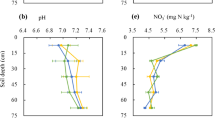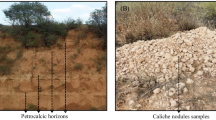Abstract
Determining the appropriate wastewater dose to supply nutrients while avoiding overirrigation is essential for achieving more balanced above- and belowground development of the plants, thereby ensuring high filtering functionality of a willow vegetation filter system. Aboveground biomass and root development of a 3-year-old willow vegetation filter in response to three increasing doses of secondary-treated urban wastewater under both fertilized and unfertilized conditions were evaluated. Fine, coarse and total root biomass, fine root length density (FRLD), specific fine root length (SFRL) and specific root area (SRA) were assessed in soil core samples collected at four different depths (0–20, 20–40, 40–60 and 60–80 cm) in all treatments. While aboveground biomass increased as wastewater amounts and fertilization increased (from 23.89 Mg ha−1 in non-irrigated condition to 47.07 Mg ha−1 in the highest wastewater dose, from 31.5 Mg ha−1 in unfertilized plots to 40.1 Mg ha−1 in the fertilized), total and fine root biomass decreased when willow was irrigated with the highest wastewater dose (i.e. total root biomass is 2.54 Mg ha−1 in non-irrigated condition—1.36 Mg ha−1 in the highest wastewater dose). The root biomass did not follow the same development pattern, and a significant decrease in fine root biomass was observed when the highest irrigation dose was applied. In these circumstances, we believe that the supply in water and nutrient is sufficient to the development of the willows which react by diminishing the amount of roots proportionally to the aboveground parts. This may lead to a higher transpiration rate and allow willows to avoid a surplus of water in the soil.


Similar content being viewed by others
Abbreviations
- SRC:
-
Short-rotation coppice
- RBD:
-
Root biomass density (Mg ha−1)
- FRLD:
-
Fine root length density (cm cm−3)
- SFRL:
-
Specific fine root length (m g−1)
- SRA:
-
Specific root area (m2 kg−1)
References
Perttu KL (1993) Biomass production and nutrient removal from municipal wastes using willow vegetation filters. J Sustain For 1(3):57–70
Truu M, Truu J, Heinsoo K (2009) Changes in soil microbial community under willow coppice: the effect of irrigation with secondary-treated municipal wastewater. Ecol Eng 35(6):1011–1020
Guidi W, Piccioni E, Bonari E (2008) Evapotranspiration and crop coefficient of poplar and willow short-rotation coppice used as vegetation filter. Bioresour Technol 99:4832–4840
Mirck J, Isebrands JG, Verwijst T, Ledin S (2005) Development of short-rotation willow coppice systems for environmental purposes in Sweden. Biomass Bioenergy 28:219–228
Dimitriou I, Rosenqvist H (2011) Sewage sludge and wastewater fertilisation of short rotation coppice (SRC) for increased bioenergy production—biological and economic potential. Biomass Bioenergy 35(2):835–842
Guidi W, Labrecque M (2010) Effects of high water supply on growth, water use, and nutrient allocation in willow and poplar grown in a 1-year pot trial. Water Air Soil Pollut 207:85–101
Perttu K, Kowalik P (1997) Salix vegetation filters for purification of waters and soils. Biomass Bioenergy 12:9–19
Aronsson P, Heinsoo K, Perttu K, Hasselgren K (2002) Spatial variation in above-ground growth in unevenly wastewater-irrigated willow Salix viminalis plantations. Ecol Eng 19:281–287
Elowson S (1999) Willow as a vegetation filter for cleaning of polluted drainage water from agricultural land. Biomass Bioenergy 16:281–290
Dimitriou I, Aronsson P (2011) Wastewater and sewage sludge application to willows and poplars grown in lysimeters—plant response and treatment efficiency. Biomass Bioenergy 35(1):161–170
Dimitriou I, Eriksson J, Adler A, Aronsson P, Verwijst T (2006) Fate of heavy metals after application of sewage sludge and wood–ash mixtures to short-rotation willow coppice. Environ Pollut 142(1):160–169
Volk TA, Abrahamson LP, Nowak CA, Smart LB, Tharakan PJ, White EH (2006) The development of short-rotation willow in the Northeastern United States for bioenergy and bioproducts, agroforestry and phytoremediation. Biomass Bioenergy 30(8–9):715–727
Volk T, Abrahamson L, White E (2001) Root dynamics in willow crops. Biomass power for rural development technical report. Syracuse, New York
Pacaldo R, Volk T, Briggs R (2013) Greenhouse gas potentials of shrub willow biomass crops based on below- and aboveground biomass inventory along a 19-year chronosequence. BioEnergy Res 6(1):252–262
Heaton RJ, Sims REH, Tungcul RO (2002) The root growth of Salix viminalis and Eucalyptus nitens in response to dairy farm pond effluent irrigation. Bioresour Technol 81(1):1–6
Volk T, Abrahamson L, White EH (2001) Root dynamics in willow crops biomass power for rural development technical report. Syracuse, New York
Rytter R, Hansson A (1996) Seasonal amount, growth and depth distribution of fine roots in an irrigated and fertilized Salix viminalis L. plantation. Biomass Bioenergy 11:129–137
Crow P, Houston T (2004) The influence of soil and coppice cycle on the rooting habit of short rotation poplar and willow coppice. Biomass Bioenergy 26(6):497–505
Jackson M, Attwood P (1996) Roots of willow (Salix viminalis L) show marked tolerance to oxygen shortage in flooded soils and in solution culture. Plant Soil 187(1):37–45
Püttsepp Ü (2004) Effects of sustainable management practices on fine-root systems in willow (Salix viminalis, S. dasyclados), Grey Alder (Alnus incana) and Norway spruce (Picea abies) stands. Swedish University of Agricultural Sciences, Uppsala
Rytter R-M (1999) Fine-root production and turnover in a willow plantation estimated by different calculation methods. Scand J For Res 14(6):526–537
Atkinson D (2000) Root characteristics: why and what to measure. In: Bengough AG, Engels C, Noordwijk M, Pellerin S, Geijn S, Smit A (eds) Root methods. Springer, Berlin, pp 1–32
Cornelissen JHC, Lavorel S, Garnier E, Diaz S, Buchmann N, Gurvich DE, Reich PB, ter Steege H, Morgan HD, van der Heijden MGA, Pausas JG, Poorter H (2003) A handbook of protocols for standardized and easy measurements of plants functional traits worldwide. Australian J Bot 51:335–380
Comas L, Bouma T, Eissenstat D (2002) Linking root traits to potential growth rate in six temperate tree species. Oecologia 132(1):34–43
Ryser P (2006) The mysterious root length. Plant Soil 286(1–2):1–6
Böhm W (1979) Methods of studying root systems. Springer, Berlin, p 188
Leuschner C, Harteveld M, Hertel D (2009) Consequences of increasing forest use intensity for biomass, morphology and growth of fine roots in a tropical moist forest on Sulawesi, Indonesia. Agric Ecosyst Environ 129(4):474–481
Gill RA, Jackson RB (2000) Global patterns of root turnover for terrestrial ecosystems. New Phytol 147(1):13–31
Bohm W (1979) Methods of studying root systems. Springer, Berlin, 188 pp
Kücke M, Schmid H, Spiess A (1995) A comparison of four methods for measuring roots of field crops in three contrasting soils. Plant Soil 172(1):63–71
Zutter B, Mitchell R, Glover G, DH G (1999) Root length and biomass in mixtures of broomsedge with loblolly pine or sweetgum. Can J For Res 29:926–933
Gwenzi W, Veneklaas E, Holmes K, Bleby T, Phillips I, Hinz C (2011) Spatial analysis of fine root distribution on a recently constructed ecosystem in a water-limited environment. Plant Soil 344(1–2):255–272
Guidi W, Pitre FE, Labrecque M (2013) Short-rotation coppice of willows for the production of biomass in Eastern Canada. In: Matovic M.D. (Eds), Biomass now -sustainable growth and use. pp 421-448. InTech ISBN 978-953-51-1105-4
Cavanagh A, Gasser MO, Labrecque M (2011) Pig slurry as fertilizer on willow plantation. Biomass Bioenergy 35(10):4165–4173
Labrecque M, Teodorescu T (2005) Field performances and biomass production of 12 willow and poplar clones in short-rotation coppice in southern Quebec (Canada). Biomass Bioenergy 29:1–9
Stadnyk CN (2010) Root dynamics and carbon accumulation of six willow clones in Saskatchewan. University of Saskatchewan
Keyes MR, Grier CC (1981) Above- and below-ground net production in 40-year-old Douglas-fir stands on low and high productivity sites. Can J For Res 11(3):599–605
Kozlowski T (1997) Responses of woody plants to flooding and salinity. Hernon, Victoria
Pezeshki SR, Anderson P, Shields FD (1998) Effects of soil moisture regimes on growth and survival of black willow (Salix nigra) posts (cuttings). Wetlands 18(3):460–470
Good JEG, Williams TG (1986) Growth responses of selected clones of birch (Betula pendula roth., B. pubescens Ehrh.) and willow (Salix caprea L., S. cinerea L.) to nitrogen in solution culture. Plant Soil 92(2):209–222
Ågren G, Franklin O (2003) Root: shoot ratios, optimization and nitrogen productivity. Ann Bot 92(6):795–800
Heilman P, Ekuan G, Fogle D (1994) Above- and belowground biomass and fine roots of 4-year-old hybrids of Populus trichocarpa x Populus deltoides and parental species in short-rotation culture. Can J For Res 24:1186–1192
Børja I, De Wit HA, Steffenrem A, Majdi H (2008) Stand age and fine root biomass, distribution and morphology in a Norway spruce chronosequence in southeast Norway. Tree Physiol 28(5):773–784
Makita N, Hirano Y, Mizoguchi T, Kominami Y, Dannoura M, Ishii H, Finér L, Kanazawa Y (2011) Very fine roots respond to soil depth: biomass allocation, morphology, and physiology in a broad-leaved temperate forest. Ecol Res 26(1):95–104
Ostonen I, Lõhmus K, Helmisaari H-S, Truu J, Meel S (2007) Fine root morphological adaptations in Scots pine, Norway spruce and silver birch along a latitudinal gradient in boreal forests. Tree Physiol 27(11):1627–1634
O’Grady AP, Worledge D, Battaglia M (2005) Temporal and spatial changes in fine root distributions in a young Eucalyptus globulus stand in southern Tasmania. For Ecol Manag 214(1–3):373–383
Bakker MR, Jolicoeur E, Trichet P, Augusto L, Plassard C, Guinberteau J, Loustau D (2009) Adaptation of fine roots to annual fertilization and irrigation in a 13-year-old Pinus pinaster stand. Tree Physiol 29(2):229–238
Kucbel S, Jaloviar P, Scaron p, aacute k J (2011) Quantity, vertical distribution and morphology of fine roots in Norway spruce stands with different stem density. Plant Root 5:46–55
Acknowledgments
This study received financial support from the MDDEFP—Quebec. The authors wish to thank Francis Allard from Agro Énergie Inc. for providing access to the experimental field. We are grateful to Alexandre Naud, Dominic Desjardins and Matthew Mosseler for their assistance during soil coring. We also wish to thank Stéphane Daigle for the statistical support and Karen Grislis for the linguistic revision.
Author information
Authors and Affiliations
Corresponding author
Rights and permissions
About this article
Cite this article
Jerbi, A., Nissim, W.G., Fluet, R. et al. Willow Root Development and Morphology Changes Under Different Irrigation and Fertilization Regimes in a Vegetation Filter. Bioenerg. Res. 8, 775–787 (2015). https://doi.org/10.1007/s12155-014-9550-5
Published:
Issue Date:
DOI: https://doi.org/10.1007/s12155-014-9550-5




